August 22, Washington DC
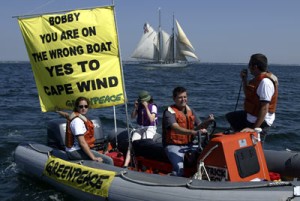
The Greenpeace ship Arctic Sunrise just completed its tour of Greenland, investigating and documenting the latest evidence of global warming. The Arctic Sunrise now travels to Canada to begin the third phase of Project Thin Ice-a tour down the East Coast of the United States. The purpose of this tour is highlighting solutions to global warming, namely the use of cleaner, climate-friendly forms of energy such as offshore wind. This photo is from a recent activity in Nantucket Sound, where Greenpeace is working and organizing in the Cape Cod area to promote the Cape Wind project, which would be the first offshore wind farm in the United States. Photo copyright Warshaw/Greenpeace.
Besides doing things like paint banners like the one in this photo, I've had the privilege this summer of working on arrangements for the U.S. East Coast ship tour. Greenpeace is holding "open boats" in Boston, New York City, and Miami in September and October as part of this tour. If you're in the area, be sure to stop by-it's a great opportunity to see a Greenpeace ship, meet the captain and crew, and learn more about what Greenpeace is doing to promote renewable energy use. Check out http://www.greenpeace.org/usa/about/ships/the-arctic-sunrise/come-onboard for exact locations and times.
As my time in Washington draws to a close, I am extremely impressed at the complex issues Greenpeace tackles with enormous dedication and energy. Project Thin Ice has been a major success thus far, first gaining worldwide attention for global warming through the One World Expedition, and then documenting the impacts of warming on the fragile Arctic region. The One World Expedition is fortunate to call Greenpeace its environmental partner. For more information on Project Thin Ice, go to www.projectthinice.org.
August 10, Amsterdam, Grand Marais, Greenland
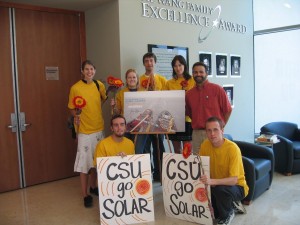
The One World Team is spanning the globe to continue their commitment to global warming. Recently, Lonnie made a trip to Long Beach, California to support another campaign. The events were a huge success as the group influenced the CSU Trustees and Chancellor's Office to push their goals further in the direction of clean energy.
Meanwhile, Eric is Amsterdam on his way to Greenland and reports: Last week I was in Grand Marais and now I am on my way to Greenland to fill in as a deck hand on the Greenpeace ship Arctic Sunrise. I am excited beyond belief at the opportunity to continue the One World commitment to better understanding the effects of global warming as well as bearing witness to these changes.
And finally, John H. writes: Greetings from South West Greenland - after 6 weeks aboard the Arctic Sunrise we have turned the corner to the West Coast of Greenland. We entered the fjord systems to Narsaq, a town whose name means The Plain.
A small-scale hydro project is under construction just east of here that should free both Narsaq and nearby Qaqortoq from dirty, and expensive, diesel electricity generation. This will supply power to around 5,000 people. Qorlortorsuaq Hydro Energy plant utilizes water from high lakes fed from the icecap, as it plummets down toward the fjord below. The project consists of a small dam under construction just east of here that will produce 7.6 MW of power. Transmission lines will also have to be set up to then bring the power to the towns of Narsaq and Qaqortoq - hopefully allowing them to shut down their dirty diesel generators for good. This project has the other advantage of being able to produce energy at a much lower cost than diesel generation.
August 3, Arctic Ocean

Satellite data for the month of June show Arctic sea ice has shrunk to a record low, raising concerns about climate change, coastal erosion, and changes to wildlife patterns.
The National Snow and Ice Data Centre in the United States uses remote sensing imagery to survey ice cover at both poles.
The centre says 2002 was a record low year for sea ice cover in the Arctic, since satellite observations began in 1979. There's evidence that may have been the lowest coverage in a century.
Now scientists fear this year could be worse. June readings indicate the ice is at its lowest limit ever for that time of year.
"It actually melted back farther than normal pretty much everywhere around the Arctic," says Walt Meier of the National Snow and Ice Data Centre in the U.S.
"Where it's been retreating the most has been north of Alaska and north of eastern Siberia."
Meier says the amount of ice that covered the Arctic Ocean in the month of June this year shrunk by a record six percent below the average rate for the month.
July 26, Greenland

Dramatic discovery Confirms Scientists' Predictions of Accelerated Global Warming
East Coast Greenland - Independent scientists on board the Greenpeace ship Arctic Sunrise recently discovered that a Greenland glacier has accelerated in the past 9 years exceeding all expectations and has now become one of the fastest moving glaciers in the world. These observations validate predictions about impacts to Greenland glaciers from recent global warming.
Outlet glaciers like Kangerdlugssuaq transport ice from the heart of the Greenland Ice Sheet to the ocean and discharge icebergs, which contribute to sea level rise. Kangerdlugssuaq Glacier alone transports or "drains" four percent of the ice from the Greenland Ice Sheet, and so any changes in the speed of these glaciers holds tremendous significance in terms of sea level rise.
"This is a dramatic discovery," said Dr. Gordon Hamilton, who undertook the measurements on Kangerdlugssuaq Glacier on Greenland's east coast with University of Maine PhD student Leigh Stearns. "There is concern that the acceleration of this and similar glaciers and the associated discharge of ice is not described in current ice sheet models of the effects of climate change. These new results suggest that the loss of ice from the Greenland Ice Sheet, unless balanced by an equivalent increase in snowfall, could be larger and faster than previously estimated."
The Arctic Sunrise is in Greenland this summer documenting the signs and impacts of global warming in this part of the Arctic. The scientists from the Climate Change Institute at the University of Maine are conducting an independently-funded study into glacier variations as evidence of recent global warming.
July 21, Greenland
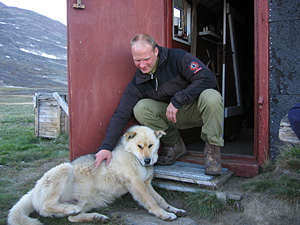
The One World team is definitely not idle. Lonnie is in California for several speaking engagements and to talk more about Global Warming and Eric is in Wisconsin on a similar mission. Meanwhile, John Hoelscher visits his old Greenland friends.
John writes: We are now in Kangerlusuaq Fjord,
doing glaciology. I took five others roped up for glacier travel last night, and we walked on a rugged glacier checking out crevasses for about 3 hours - was quite a buzz. Should leave in about 24 hours.
On venturing ashore to visit the rustic Zackenberg hunting hut, established by the Nanoq trading company in 1930, I had the fortune of meeting one of the twelve members of the Sirius Sledge Patrol team, Jesper Christensen. He was nearing the end of his two-year tour at Daneborg, the headquarters of this Danish Military outpost, which has been in operation since 1950. Its primary purpose is to maintain a military presence and patrol an area of 160,000 square kilometers, the world's largest national park.
Before the Sirius Patrol was established with the advent of the Cold War, the Greenland Sledge Patrol, made up from East Greenland civilian hunters, operated during WW2, with the task of patrolling the eastern coastline to look for secret German weather stations set up to forecast the weather, necessary for scheduling bombing raids on allied targets across the UK. In fact, there was one famous encounter near Eskimoness, Clavering Island, where the party did chance upon the German soldiers.
July 12, GM, DC and Greenland
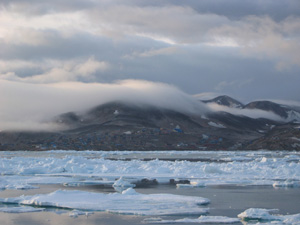
Sure it's 85 degrees and as hot as it ever gets in Grand Marais, but that isn't stopping us from thinking about the future. On July 18, 2006 OWE will make another summer attempt at crossing the ocean's broken sea ice from the North Pole to Cape Morris Jessup, Greenland.
The 50-day expedition will cover 540 miles pulling 160-pound modified whitewater canoes. We expect to reach landfall by September 5th, the last day of 24 hours light and the start of fall storms and precipitation. The route was picked due to favorable southerly drift of the sea ice.
The team will be flown to the expedition's start at the North Pole by Russian helicopter out of Norway's Spitzbergen Island. At Cape Morris Jessup, Greenland's northernmost land and expedition's finish, the team will be picked up by Twin Otter aircraft and flown back to Canada or Iceland then home.
John Hoelscher sends this message: We arrived at the anchorage in front of the East Greenland town of Ittoqqortoormiit (Scoresbysund), located near the northern entrance to Scoresby Sound - the world's largest fjord complex, around midnight. This isolated town of around 550 people was established in 1925 when families from the Ammassalik District, around 700 km south, were brought north to this location. It was known that it was rich in marine life and food for the people who traditionally catch seals, walrus and polar bears. Also on the land in the fjord system muskoxen can be found grazing on the grasses and lichen.
Ann reports from Washington D.C.: I'm also involved in the ship tour the Arctic Sunrise will be making down the east coast of the U.S. in early September, working with communities in Massachusetts and New York to promote and implement cleaner, climate-friendly forms of energy such as offshore wind. Stay tuned for more details on this leg of the tour, or check the Project Thin Ice Web site
July 5, East Greenland
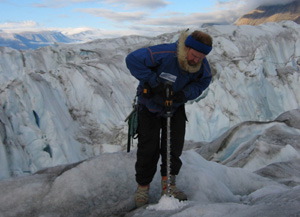
My daily duties on board the ship have been to be on Watch twice daily for 4 hours, maintenance to the ship's equipment and field training and logistics support for the science programs. I have been training some crew in glacier travel, safety in the field and Greenlandic customs and way of life up here.
The past two days we were at anchor at the end of Scoresby Sound, the world's largest fjord (350km long) in a sheltered bay with icebergs drifting by, and high mountains (up to 1800 m) and glaciers drooping down off the distant ice cap. The lower land here has some green grass, flowers and shrubs, and musk oxen and arctic hare have been sighted nearby. The air temperature is about 5 degC, and today the wind was calm. The past few days there have been low clouds and fog, but that lifted yesterday to reveal these majestic peaks.
The past two days I have been assisting two glaciologists in surveying the velocity of the nearby Daugaard Jensen glacier. We have now left this site and are looking down the fjord to see if the weather will allow us to conduct further glaciology in Vestfjord, otherwise we will go on to the town of Ittoqortoormiit (Scoresbysund) to visit the locals, catch up with friends and interview some of the elder hunters etc about what they've witnessed with regards to climate change. We have quite a few adventures in store the next two months. We hope to head north toward Zackenburg arctic research station in Greenland's national park (the world's largest) and then head south around southern Greenland and visit some towns and glacial areas on Greenland's west coast. I'm sure I will have plenty to talk about once I return to Australia in September.
